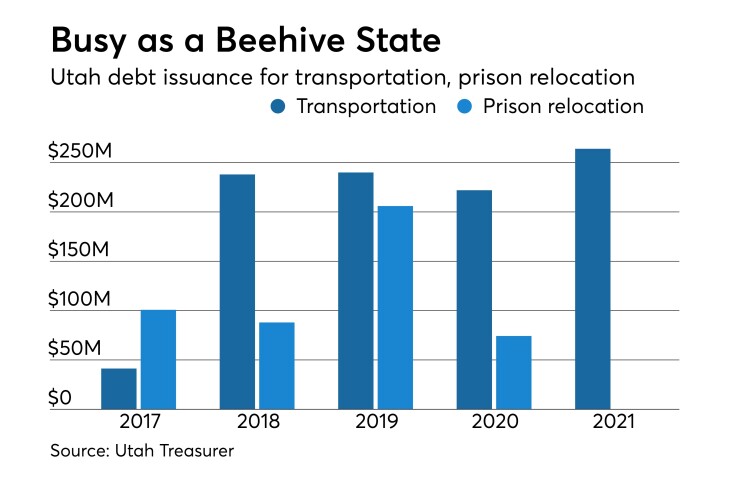Risk-averse investors in a lean muni market will get a shot at Utah’s triple-A credit next week as the Beehive State prices $326 million of general obligation bonds.
The sizable deal from an infrequent issuer is scheduled for Feb. 6 and will raise money for an ambitious prison relocation project and for transportation.

JPMorgan is book-runner on the deal, with managing director Stephanie Tomblin and executive director Marshall Kitain as lead bankers.
Jon Bronson, managing director at Zions Bank is financial advisor. Utah Treasurer David Damschen is supervising the transaction for the state.
The deal includes a $238.2 million par amount for transportation projects under Senate Bill 277 passed by the 2017 Legislature. Those bonds are expected to provide $285 million of proceeds.
Total bond authorization under the bill came to $1.01 billion. The first $41.3 million was issued in 2017. After this sale, Utah expects to offer $239.9 million in 2019 with another $221.6 million in 2020. The final $236.7 million will come the next year. The highway bonds mature in 14.5 years.
The upcoming issue includes $88.25 million of par toward relocating the state prison in Draper to Salt Lake City. Expected to provide $100 million of proceeds, the bonds maturing in 8.5 years were authorized by the 2017 Legislature under House Bill 460. Lawmakers added $100 million to the $470 million approved by the 2015 Legislature as House Bill 460.
These prison bonds are second issue following a $100.8 million issue of 10-year bonds in 2017. The state expects to issue another $205.6 million in 2019 that will mature in 6.5 years and a final $74.3 million of 5.5-year maturities in 2020.
With a conservative approach to debt and other fiscal matters in a growing economy, Utah was in no danger of losing its across-the-board triple-A ratings from the top three ratings agencies. Outlooks from Moody’s Investors Service, S&P Global Ratings and Fitch Ratings were stable.
Utah’s history of continuous AAA bond ratings dates to 1965, when S&P initiated its rating system. The State’s AAA rating with Moody’s began in 1973. Fitch Ratings added its top rating in 1992.
“Maintaining the highest credit ratings saves Utah taxpayer dollars by allowing us to finance large projects at the lowest interest rates available,” Damschen noted. “These ratings are indicative of good financial management practices and a strong economy.”
S&P analyst Christina Marin praised Utah’s practice of breaking out one-time revenues for one-time projects and building reserves during times of expansion.
“Adding to the stability of Utah's credit quality, in our view, is that the state's revenues are currently in a growth mode, allowing Utah to strategically invest in its transportation infrastructure and increase funding for its growing school age population,” Marin said.
“Factors that could cause negative rating pressure, in our opinion, would include the state falling out of long-term structural balance, or a significant rise in long-term liability levels, although we do not anticipate this occurring over the next two years,” she added.
The prime motivator to move the state prison from Draper to an undeveloped site in Salt Lake City was economic development at the prison site known as Point of the Mountain.
The 700-acre site is expected to become part of a growing high-tech development midway between the University of Utah in Salt Lake City and Brigham Young University in Provo.
“The value of the prison site is largely dependent on the economic success of the entire surrounding area, and the economic success of the surrounding area is dependent on a forward looking plan for the prison site,” according to the planning organization Envision Utah.
According to a 2005 study by Wikstrom Economic & Planning Consultants the cost of relocating the prison far exceeded the value that could be realized from the sale of the Draper prison site. Despite that finding, a special session of the state legislature in 2015 voted to move the prison to the west side of Salt Lake City.
In 2016 the Prison Development Commission reported that the cost of building a replacement prison at a new location would be $100 million higher than the $550 million already approved. That prompted Utah Gov. Gary Herbert to call for the additional bonds in the 2017 session.
Despite objections to the higher cost, Herbert emphasized that the additional funds were not due to cost overruns at the new site between the airport and Great Salt Lake.
Salt Lake City Democrats objected to the expense for a project they said the city never wanted at the 350-acre site, which is surrounded by wetlands. In fact, no community openly sought the new prison.
"This was one of the most expensive sites," Sen. Luz Escamilla, D-Salt Lake City, told the Senate. "We need to be reminded this was a fiscally irresponsible decision that was made by this Legislature, and now we're paying consequences by putting $100 million more to this project."
With groundbreaking last August, the new prison is expected to be completed in 2020.
In the current legislative session, Herbert is proposing a $16.7 billion state budget that contains no tax increases and incurs no new debt.
As a result of federal tax reform, Utah is expected to receive a $200 million increase in revenue. Lawmakers will debate whether to keep that money as a windfall or return it to taxpayers in the form of a tax cut.
Herbert’s budget proposes to directly invest 72% of all new ongoing revenue in public and post-secondary education. That provides an annual investment of $207.5 million in ongoing funding for public education and $68.6 million in ongoing funding for post-secondary education.
With a population of more than 3 million, Utah grew at a rate of 2.03% from 2015 to 2016, the fastest in the nation. Utah’s unemployment rate is 3.3%, well below the national average of 4.1%. The state’s median household income of $67,481 ranks 12th among the states.





